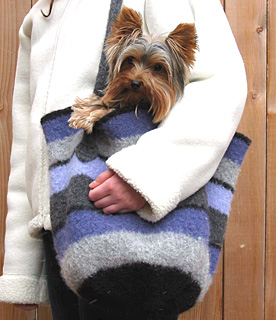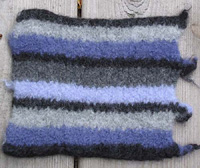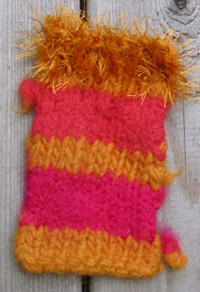|
By
Kathy Wortel
 Felted
wool brings back bad memories for me. I remember a
gorgeous wool and angora sweater that I had purchased
as a teenager with my hard-earned babysitting dollars.
Somehow my sweater got mixed in with the family wash
and you can guess the rest. Felted
wool brings back bad memories for me. I remember a
gorgeous wool and angora sweater that I had purchased
as a teenager with my hard-earned babysitting dollars.
Somehow my sweater got mixed in with the family wash
and you can guess the rest.
But
the properties of wool that make it felt so easily,
can also be used to our advantage. The reason woolen
items felt, with water and agitation, is that the
scales on the wool swell, rub against each other and
bind together, creating a denser, shrunken fabric.
Items must be knit somewhat loosely on larger needles
to enable the fiber to felt properly. Calculating
the amount of shrinkage ahead of time will enable
you to create a felted purse, vest, cell-phone cover,
or whatever tickles your fancy.
Untreated
wool usually felts beautifully, but steer clear of
anything labeled "superwash" as the coating
that enables it to be machine-washed will also prevent
felting. Mohair also felts wonderfully, but not all
yarns will felt at the same rate or density - another
reason why swatching is essential.
A
swatch will tell you all you need to know to make
a simple knitted item. Comparing the before and after-felting
measurements of the swatch, you can quickly figure
how large to knit an item in order to end up with
it felted to your desired size. Items with more shaping
are more complicated, and require either more experimenting
or going the easier route and purchasing a pattern
by a company like FiberTrends,
who’ve already done the math to come up with
more complex patterns for mitts, clogs, and other
items.
For
my first foray into felting [see result above], I
decided to use up some oddballs left over from previous
projects. I had several colours of Brown Sheep Naturespun
and Brown Sheep Lamb’s Pride which I thought
I could turn into a multicolour felted bag. However,
I did not have a pattern and didn’t know how
Naturespun and Lamb’s Pride would felt. So I
made a swatch. I worked out a striping sequence and
knit up a large swatch, carefully measuring its dimensions
before felting. I also did not weave in my ends as
I changed colours, instead just tied each new colour
to the old with a square knot and trimmed the ends,
as I wanted to see how this would last through the
felting process.
 Most
people felt using hot water, but I’ve seen items
quickly hand-felted with lukewarm water. I went the
easy route: hot water and a washing machine. I put
my swatch in a zippered pillow protector and threw
it in my washer with a pair of old jeans for increased
agitation. After 15 minutes my swatch [at left] had
felted quite nicely. I let it dry flat for a day and
then measured the shrunken dimensions. The felting
had shrunk the swatch more lengthwise than in width.
Using the before and after measurements I was able
to determine roughly how large to knit a bag, in the
round, that after felting would be the perfect size
to carry my knitting. (see photo — "Felted
Bag") The square knots where I had changed colours
did not come undone in the felting process and I simply
snipped off the fuzzy ends after the swatch, and bag,
were felted. Most
people felt using hot water, but I’ve seen items
quickly hand-felted with lukewarm water. I went the
easy route: hot water and a washing machine. I put
my swatch in a zippered pillow protector and threw
it in my washer with a pair of old jeans for increased
agitation. After 15 minutes my swatch [at left] had
felted quite nicely. I let it dry flat for a day and
then measured the shrunken dimensions. The felting
had shrunk the swatch more lengthwise than in width.
Using the before and after measurements I was able
to determine roughly how large to knit a bag, in the
round, that after felting would be the perfect size
to carry my knitting. (see photo — "Felted
Bag") The square knots where I had changed colours
did not come undone in the felting process and I simply
snipped off the fuzzy ends after the swatch, and bag,
were felted.
 For
my current Knitty felted tote bag, Suki,
I started once again with swatches. This time I doubled
the yarn and used even larger needles, speeding up
the knitting process. The first swatch [at right]
was made with pink and coral Naturespun, gold Lamb’s
Pride, and some gold Fizz. After felting I noticed
that the Lamb’s Pride still had some stitch definition
and did not felt as quickly and uniformly as the Naturespun.
In my previous bag this didn’t matter much, as
the Lamb’s Pride was only used in thin black
bands, but I wanted this new bag to felt as uniformly
as possible. So I did another swatch using only Naturespun
(see photo below). This swatch felted very evenly
and I used its dimensions to determine how big to
make my Knitty bag. For
my current Knitty felted tote bag, Suki,
I started once again with swatches. This time I doubled
the yarn and used even larger needles, speeding up
the knitting process. The first swatch [at right]
was made with pink and coral Naturespun, gold Lamb’s
Pride, and some gold Fizz. After felting I noticed
that the Lamb’s Pride still had some stitch definition
and did not felt as quickly and uniformly as the Naturespun.
In my previous bag this didn’t matter much, as
the Lamb’s Pride was only used in thin black
bands, but I wanted this new bag to felt as uniformly
as possible. So I did another swatch using only Naturespun
(see photo below). This swatch felted very evenly
and I used its dimensions to determine how big to
make my Knitty bag.
 The
second and third swatches had a band at the top where
I used one strand of Naturespun combined with a strand
of eyelash yarn. The doubled Naturespun felts a little
more tightly than the Naturespun/eyelash combination,
so I knew I had to work in some increases after the
band to produce an even felted fabric. The
second and third swatches had a band at the top where
I used one strand of Naturespun combined with a strand
of eyelash yarn. The doubled Naturespun felts a little
more tightly than the Naturespun/eyelash combination,
so I knew I had to work in some increases after the
band to produce an even felted fabric.
Felted
swatches can also be put to use when you no longer
need them to calculate shrinkage. I used the second
and third swatches to make a cell-phone cover and
an eyeglass case. A square felted swatch makes a great
mug coaster or pot-holder. A swatch is your starting
point — and there’s really no limit to what
you can do with this amazing fabric.
|

